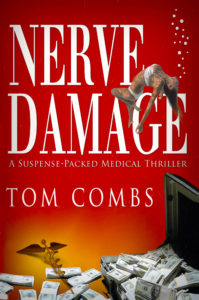Let’s start with a weird one.
Every Easter, Norwegians curl up with a murder mystery—yes, it’s a thing. It’s called Paskekrims (Easter Crime), and it’s become a cultural phenomenon that helps explain the broader global fascination with what we now call Nordic Noir.
Nordic Noir is one of the most distinctive and powerful genres in modern crime fiction. It’s bleak. It’s brooding. And it’s booming.
At its core, Nordic Noir is a subgenre of crime fiction rooted in the Scandinavian region—primarily Norway, Sweden, Denmark, Finland, and Iceland. It’s defined by a cold, moody atmosphere, morally complex characters, stark landscapes, and a tendency to tackle tough social issues. And readers (and viewers) can’t seem to get enough of it.
These stories often feature detectives who are brilliant but broken. They drink too much. They carry baggage. And they stumble through layers of societal decay while trying to solve some pretty grisly crimes.
Unlike the fast-paced, high-gloss thrillers of the American tradition, Nordic Noir takes its time. It broods. It simmers. It invites readers into a grim world where the answers aren’t easy and justice is rarely clean.

So, what makes this genre so addictive?
It’s not just the murders—although Nordic Noir rarely skimps on body count. It’s the mood, the psychology, and the haunting realism. These stories feel like they could actually happen, and maybe already did.
If you’ve read The Girl with the Dragon Tattoo by Stieg Larsson, you’ve tasted the genre. Larsson helped ignite the global boom in Nordic Noir with his Millennium trilogy. But he wasn’t the first—and he won’t be the last.
Let’s rewind. The roots of Nordic Noir go back to the 1960s, when Swedish couple Maj Sjöwall and Per Wahlöö wrote a ten-book series featuring detective Martin Beck. Their work combined police procedural storytelling with pointed critiques of the Scandinavian welfare state. It was slow-burning, socially conscious, and incredibly influential.
From there, the torch passed to Henning Mankell. His Kurt Wallander novels cemented the genre’s tone—gritty, introspective, and unflinchingly honest about human flaws. Mankell sold over 40 million books worldwide and inspired a hit British TV series starring Kenneth Branagh.
Then came Jo Nesbø. The Norwegian rocker-turned-writer gave us Harry Hole, a deeply damaged detective with a nose for murder and a streak of self-destruction a mile wide. Nesbø’s books are dark, violent, smart, and among the most commercially successful crime novels in the world.
Other heavy hitters include:
- Camilla Läckberg – Known for her Fjällbacka series, blending domestic drama with psychological suspense.
- Arnaldur Indriðason – Icelandic master of mood, famed for his melancholic Inspector Erlendur
- Yrsa Sigurðardóttir – Iceland again, combining crime with a touch of horror.
- Jussi Adler-Olsen – Danish author of the Department Q series, known for its humor and depth.
- Åsa Larsson, Tove Alsterdal, and a growing chorus of new voices bringing even more nuance and variety to the genre.
The settings matter almost as much as the characters. Long, dark winters. Snow-covered forests. Isolated cabins. Stark urban backdrops. The geography of Scandinavia becomes a character in itself—one that seeps into the bones of the story.
And then there’s Paskekrims—which literally translates to “Easter Crime.”
Since the 1920s, Norwegians have been reading murder mysteries during Easter break. Publishers release special “Easter Thrillers” just for the occasion, often advertised on milk cartons, buses, and chocolate egg wrappers. It’s a country-wide obsession that shows just how culturally embedded crime fiction is in Nordic life.
So why is Nordic Noir so popular beyond Scandinavia? Three reasons.
First, it’s authentic. These stories aren’t sugarcoated or over-produced—they reflect real social anxieties, from immigration and inequality to misogyny and corruption.
Second, it’s cerebral. The puzzles are dense, the motives complex, and the moral lines fuzzy. Readers get to engage their brains, not just their guts.
Third, it’s emotional. Despite their stoicism, these characters bleed—inside and out. And their quiet suffering makes them deeply relatable, even as they chase monsters through the snow.
From a reader demographic standpoint, Nordic Noir draws a global audience. It’s especially popular among readers aged 30 to 65 who enjoy character-driven crime fiction with psychological depth. Women make up a large portion of the readership, particularly for authors like Läckberg and Sigurðardóttir.
And it’s not just books. Nordic Noir has exploded on screen, too. Think The Bridge, Borgen, Trapped, Wallander, Deadwind, Snabba Cash, and The Killing. These series have reached international audiences through streaming platforms like Netflix and HBO, often adapted into American or British versions.
As crime writers, there’s a lot we can learn from Nordic Noir. You don’t need a ton of action if you’ve got atmosphere and character. You don’t need a tidy ending if you’ve earned emotional truth. And sometimes, the most terrifying villain isn’t the killer—it’s the society that lets it all happen.
Looking ahead, Nordic Noir isn’t going anywhere. New voices are emerging, and old ones are evolving. The genre is diversifying, tackling fresh issues like environmental collapse, tech dystopias, and generational trauma—all with that trademark Scandinavian chill.
There’s even crossover with other genres now—crime blended with sci-fi, climate fiction, and historical mystery. The cold, it seems, has legs.
So if you’re a crime writer looking to expand your style, sharpen your realism, or deepen your emotional range, study the Nordics. Read them. Watch them. Analyze how they use silence, setting, and character wounds to elevate what could otherwise be just another dead body in the snow.
And hey, maybe next Easter, you’ll find yourself curled up with a Paskekrims of your own.
Kill Zoners — Who out there is into Nordic Noir? Any suggestions as to other NN authors and books? Comments?

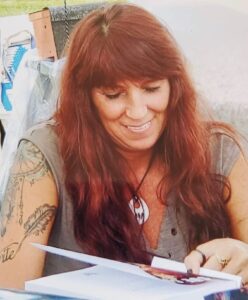
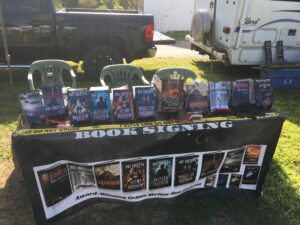 All book signings don’t need to be held in bookstores or libraries. I’ve had some of my most successful signings at local fairs and Old Home Days, and I’ve sold out and scored numerous book club invites.
All book signings don’t need to be held in bookstores or libraries. I’ve had some of my most successful signings at local fairs and Old Home Days, and I’ve sold out and scored numerous book club invites.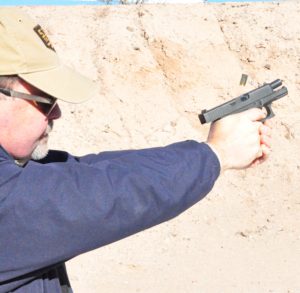
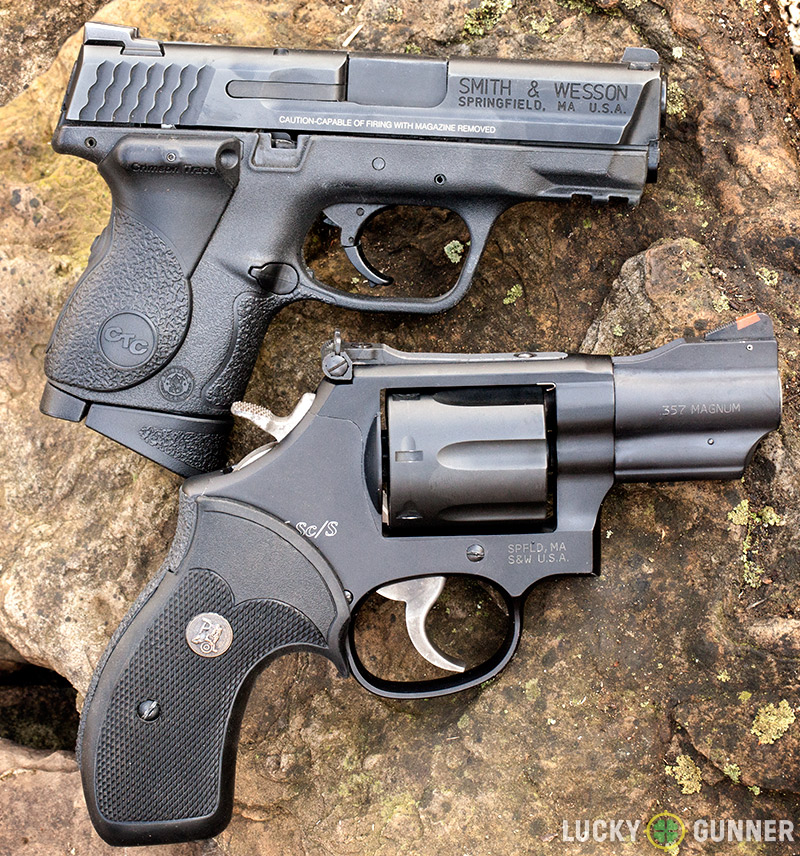 e mutually exclusive. Both are handguns, but they operate under entirely different principles. A revolver, otherwise known as a “wheel gun”, holds its cartridges in a cylinder that rotates as the hammer comes back and prepares for each shot. The revolver in the picture features an external hammer, and can be fired double action (DA) or single action (SA), which makes it a DA/SA revolver. (Double action means that with the hammer down, a single pull of the trigger with bring the hammer back, rotate the cylinder, and then drop the hammer again, firing the gun. Single action would describe the condition where the hammer is manually cocked and remains back–“condition zero”. From this condition, the trigger is more sensitive by a large margin.) Generally, there are no external safeties on a revolver. The fact of the long DA trigger pull functions as a safety. Only a fool would carry a revolver in condition zero.
e mutually exclusive. Both are handguns, but they operate under entirely different principles. A revolver, otherwise known as a “wheel gun”, holds its cartridges in a cylinder that rotates as the hammer comes back and prepares for each shot. The revolver in the picture features an external hammer, and can be fired double action (DA) or single action (SA), which makes it a DA/SA revolver. (Double action means that with the hammer down, a single pull of the trigger with bring the hammer back, rotate the cylinder, and then drop the hammer again, firing the gun. Single action would describe the condition where the hammer is manually cocked and remains back–“condition zero”. From this condition, the trigger is more sensitive by a large margin.) Generally, there are no external safeties on a revolver. The fact of the long DA trigger pull functions as a safety. Only a fool would carry a revolver in condition zero.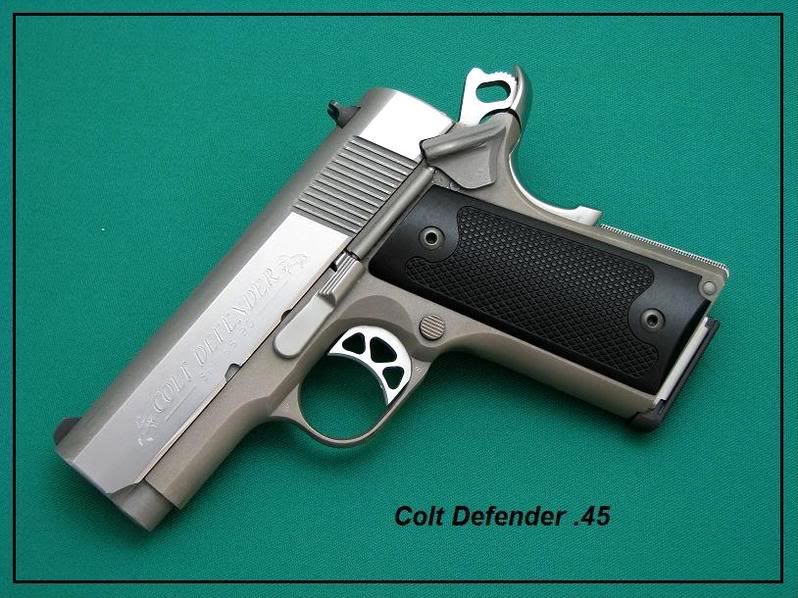 A pistol, on the other hand, carries its load in a magazine that is inserted in the grip. As the weapon fires, the slide cycles, ejecting the spent shell casing and pushing the next round into battery. The picture at the top of this post of me at the range shows this cycling action of a Glock 36 at 1/4000 of a second–thanks to my son, Chris, for getting the picture.
A pistol, on the other hand, carries its load in a magazine that is inserted in the grip. As the weapon fires, the slide cycles, ejecting the spent shell casing and pushing the next round into battery. The picture at the top of this post of me at the range shows this cycling action of a Glock 36 at 1/4000 of a second–thanks to my son, Chris, for getting the picture.  The pistol in the picture with the revolver has no hammer, but is rather “striker fired”–a distinction that is best left to a future post. Striker fired pistols may or may not have external safeties. Some pistols have external hammers, such as the Colt Defender in the picture. As shown, the Colt is in condition one, which means cartridge in the chamber, hammer back and safety on–otherwise known as “cocked and locked.” In yet another iteration, many manufacturers make DA/SA pistols. The Bersa Thunder in the photo offers a very long, hard DA trigger pull for the first shot, which leaves the hammer back for a SA follow-up shot. For most DA/SA pistols, the “safety” is not a safety at all, but rather a de-cocker, which safely returns the hammer to its DA position.
The pistol in the picture with the revolver has no hammer, but is rather “striker fired”–a distinction that is best left to a future post. Striker fired pistols may or may not have external safeties. Some pistols have external hammers, such as the Colt Defender in the picture. As shown, the Colt is in condition one, which means cartridge in the chamber, hammer back and safety on–otherwise known as “cocked and locked.” In yet another iteration, many manufacturers make DA/SA pistols. The Bersa Thunder in the photo offers a very long, hard DA trigger pull for the first shot, which leaves the hammer back for a SA follow-up shot. For most DA/SA pistols, the “safety” is not a safety at all, but rather a de-cocker, which safely returns the hammer to its DA position. If your character is an on-duty cop or active duty military, where sidearms are worn in some kind of duty rig, the sky’s the limit for what they want to carry. You can buy holsters for all kinds of hand cannons. The choices become more limited when it’s important for your character to conceal his or her weapon. As a general rule, the larger the firearm, the harder it is to conceal. The obvious corollary is that bigger people can conceal bigger guns.
If your character is an on-duty cop or active duty military, where sidearms are worn in some kind of duty rig, the sky’s the limit for what they want to carry. You can buy holsters for all kinds of hand cannons. The choices become more limited when it’s important for your character to conceal his or her weapon. As a general rule, the larger the firearm, the harder it is to conceal. The obvious corollary is that bigger people can conceal bigger guns. When it comes to carrying a gun on one’s belt, the critical first choice is inside-the-waistband (IWB) vs. outside-the-waistband (OWB), and both mean exactly what the words say. Generally, OWB carry is more detectable,
When it comes to carrying a gun on one’s belt, the critical first choice is inside-the-waistband (IWB) vs. outside-the-waistband (OWB), and both mean exactly what the words say. Generally, OWB carry is more detectable,  but with the right holster and an effective cover garment, it can be very effective. By contrast, IWB carry allows for concealment by means as simple as an untucked T-shirt. On the downside, the gun takes up waistband real estate that would otherwise be used by the waist.
but with the right holster and an effective cover garment, it can be very effective. By contrast, IWB carry allows for concealment by means as simple as an untucked T-shirt. On the downside, the gun takes up waistband real estate that would otherwise be used by the waist.  If your character wears skinny jeans, IWB could be a problem. IWB carry positions are referred to as positions on a clock face, where one’s navel would be 12 o’clock and the right hip would be 3 o’clock. The IWB position in the picture is referred to as “appendix carry”, and for the life of me, I don’t know how he would be able to sit down. Shoulder rigs are popular in movies and television shows, but I
If your character wears skinny jeans, IWB could be a problem. IWB carry positions are referred to as positions on a clock face, where one’s navel would be 12 o’clock and the right hip would be 3 o’clock. The IWB position in the picture is referred to as “appendix carry”, and for the life of me, I don’t know how he would be able to sit down. Shoulder rigs are popular in movies and television shows, but I 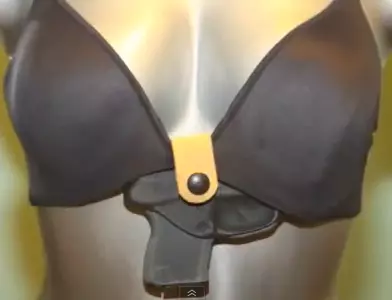 have never met a real person who wore one and didn’t hate it over time. They’re hard on the shoulders, and you can never let your arms hang normally. But the deal breaker for me would be that during the draw stroke, you pretty much have to point the gun at the person behind you, and then subsequently at yourself. That violates the basic tenets of firearm safety–as do many of the specialty retention devices such as the bra holster. ‘Nuff said, can we agree?
have never met a real person who wore one and didn’t hate it over time. They’re hard on the shoulders, and you can never let your arms hang normally. But the deal breaker for me would be that during the draw stroke, you pretty much have to point the gun at the person behind you, and then subsequently at yourself. That violates the basic tenets of firearm safety–as do many of the specialty retention devices such as the bra holster. ‘Nuff said, can we agree? the only concealment option is a vest pocket, or perhaps a boot? Search the Web for specialty guns that are actually well-made and very effective for what they are. North American Arms makes a mini-revolver that easily fits in your fist, and can be chambered in .22 magnum, a round that shows very similar terminal ballistics to a .38 special, un
the only concealment option is a vest pocket, or perhaps a boot? Search the Web for specialty guns that are actually well-made and very effective for what they are. North American Arms makes a mini-revolver that easily fits in your fist, and can be chambered in .22 magnum, a round that shows very similar terminal ballistics to a .38 special, un der ideal circumstances. The tiny, nearly non-existent barrel is a problem for a shot longer than, say, 10 yards, but as a belly gun, it’s kind of impressive, and since it’s a revolver, your character gets five tries to bring justice to another character.
der ideal circumstances. The tiny, nearly non-existent barrel is a problem for a shot longer than, say, 10 yards, but as a belly gun, it’s kind of impressive, and since it’s a revolver, your character gets five tries to bring justice to another character.
